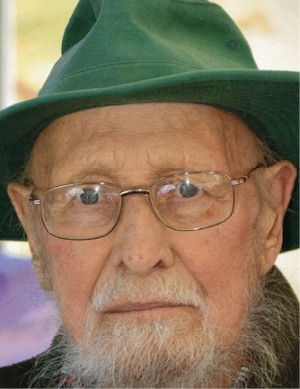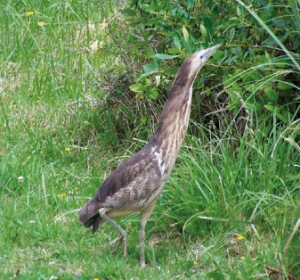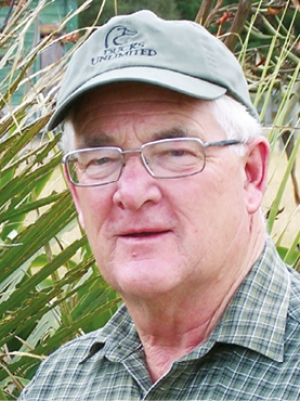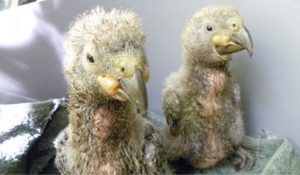Super User
Getting the lowdown on DUNZ
Clean and green the aim
The centre spread has an article about working to clean up streams, and one of our members – Ossie Latham – is a driving force behind that initiative. Landcare Trust regional co-ordinator in the Manawatu, Alastair Cole regards Ossie as a community champion for the effort he has put in over the past few years to encourage other landowners to help clean up the streams and the rivers.
Trees have been planted, and streams fenced off, locals (not only farmers, also lifestylers) have embraced the clean streams idea, and a local school has taken on the idea as a continuing project.
Most farmers are enthusiastic about the project and one said he hopes it won’t be long before fish are seen again and the birdlife flourishes.
DU members with a squirrel nature may have older Flight magazines tucked in a cupboard. In Flight 195, April 2014, page 5, you will find a story about Ossie, and the beginning of this initiative.
An OkPinion - The best way
Nitrogen (N) a colourless, odourless, tasteless gaseous element – melting point – 209.90C boiling point – 195.8C can be bought from outlets such as BOC (British Oxygen) and Air Liquid throughout NZ. (See contacts below).
The liquid boils off rapidly as a gas, into the atmosphere – therefore it must be kept as cold as possible at all times. A quality thermos flask is essential to obtain the nitrogen with, from the supplier. Keep it out of sunlight, away from any heating sources preferably low down in a fridge – or better still in a freezer. When travelling with it, you simply can’t have enough insulation around.
Nitrogen is frequently used by medical practitioners to control or eliminate various undesirable skin developments such as warts. It’s extremely low temperature when liquefied has a burning effect and thus kills off such growths very efficiently. Pain levels from this treatment are stinging but easily bearable. An improvement on surgery (sometimes butchery?).
Step one: Remove almost all the length of the shafts of a few of the outer primary feathers – one wing only, of course. (Yes – it has happened!) Cut the shaft down to just above the blood line.
Step Two: Kill off the “roots” of the feather by applying the liquid nitrogen liberally. You may have to repeat the procedure once of twice, taking it lower each time.
Younger birds tend to give easier and better results, so if possible pinion them sooner rather than later – but with this method it is never totally too late.
Killing off the base of a few feathers to prevent any re-growth is in my book much better done by this method rather than by invasive (minor as it may be) surgical methods affecting the carpels and risking infection and possibly attracting predation.
Alan Fielding
988 Great South Road,
Penrose, Auckland,
New Zealand.
Ph:0800 111 333.
Fax:0800 229 923.
Air Liquide New Zealand Limited
19 Maurice Road,
Penrose,
Auckland 1061.
PO Box 12846, Penrose, Auckland 1642.
Telephone: +64-9-622 3880
Fax: +64-9-622 3882
Website: http://www.airliquide.com
Ambrose Aquila (Andy) Gurney
Ambrose Aquila (Andy) Gurney had a great send off
I followed and with a long list of people who had sent their condolences and commented about his tireless contribution to everything he took part in. I also paid tribute to the incredible support Andy had received from - Joan, Duncan and Barry Silvester.
Allan Wilde read a delightful poem on Andy’s duck shooting exploits.
There were some impressive photos of Andy in the foyer and his coffin was draped in a camo net, with a pair of his boots and a pair of mallard decoys.
Ambrose - A male name: from a Greek word meaning “Immortal”.
Aquila - Latin, meaning “Eagle” So, Andy was – Immortal Eagle – We think he would have been proud of that.
Neil Hayes
Andy lived in Featherston and was a life member of DUNZ.
Through his friends, Joan and Duncan Smith, Andy arranged for five duck prints he had accumulated over the years to be donated to DU to be auctioned at this year’s conference, with the proceeds going to wetland restoration. Jim Campbell collected the prints and they were duly auctioned.
PS. Duncan mentioned that Andy has an Argo 8*8 that his executors will want to sell. Again, Duncan would be the person to contact. I also have a few details.
Habitat te Henga
Mutterings from the Marsh
Although rarely seen, their radio transmitters give the show away and let us know they have tended to take up residence in separate parts of the wetland. Many are clustered within a few hundred metres of the release site, while others have shunned their companions and are contentedly at the extremes of the wetland, west or east.
Required by the Pateke Recovery group to monitor the birds intensively for the fist six months, but only at monthly intervals beyond, we have been able to have volunteers maintain a weekly survey. With spring upon us and with certain pairs sticking close to each other we hope the more frequent monitoring will give us an indication if nesting is occurring.
Another more sombre reason though is that if a mortality signal is generated, we might be aware sooner and be able to recover a body to possibly determine cause of death. Three times we have had the mortality tone, and two carcasses were found while in the third case the transmitter was accurately tracked to almost 2-metre deep water. Was this a death or a case of harness failure? With that possibility and with an analysis of one carcass that showed no signs of predation but rather a tarsus fracture indicating a probable duck vs. vehicle incident, we have been fairly pleased with our predator control measures.
Maintaining predator control has been a large group of volunteers who check traps- some on their own properties, others checking traps on private or public land. Almost half of the traps though, are tended by our contractor who walks two 12 -14 km trap lines on a regular two weekly schedule. This large number of traps has allowed us to conduct an experiment which is ongoing.Alternate traps are baited with salted rabbit meat or a commercial dried rabbit product. The Statistics Department of Auckland University is analysing the results and by next year will be able to tell us if one is more efficient a lure than the other.
A contentious topic recently, but one I’ve been promoting is the use of UAV not for the casual model aircraft enthusiast, but as a genuine conservation tool. Chancing upon a local UAV manufacturer I was able to get him to look into using a UAV [drone] as an aerial radio receiver.
Other activities include a recent extensive survey of fernbird at three sites comparing the Forest & Bird reserve where predator control has been maintained for 15 years to two new sites only trapped over the past 18 months. This will give baseline date to use when we are able to add rodent control to some of the new sites. Spotless crake were to come in for a similar survey using sound playback in early October.
Meanwhile bittern are being seen more and more frequently. Nice to think it is due to our pest management, but it’s as likely to be due to more observations by interested persons. As with most conservation though, the hardest task is fundraising and a second translocation next year is dependant on successful applications. I’ll tell you how that went in a future update.
John Summich.
Blue Rock shoot at Martinborough
Australasian bittern/matuku
Bitterns are found throughout New Zealand - in the North Island they predominantly inhabit Northland, Waikato and East Coast wetlands; while in the South Island they mostly inhabit West Coast, Canterbury and Southland wetlands. The most important bittern site nationally is Whangamarino Wetland, a large and diverse wetland complex in the Waikato.
Bitterns are large, stocky birds, with streaky dark brown and beige plumage on their throat, breast, abdomen and thighs; and dark brown on the neck and back. The head is dark except for pale beige around the cheek, forming a pale eyebrow. Plumage can vary significantly and may be age related.
Bitterns are rarely sighted due to their exceptionally cryptic behaviour, inconspicuous plumage resulting in excellent camouflage and the inaccessibility of many wetlands. They are mostly active at dawn, dusk and throughout the night. Bitterns are occasionally spotted in the open along wetland edges, drains, flooded farmland and roadsides.
They are very sensitive to disturbance and will silently creep away to avoid detection, or adopt the infamous ‘freeze’ stance (with the bill pointing skyward) if approached. This allows bitterns to blend into many environments, whilst maintaining a close watch of surroundings. If an observer continues to advance on a bittern, then it will eventually take flight in a laborious manner.
Often the only sign of bittern presence in a wetland is the male’s distinctive booming call at the beginning of the breeding season. Each call sequence may consist of 1-10 individual booms, with an average of 3 booms. Boom sequences are repeated at regular intervals, and normally preceded with inhalations or gasps. Females are mostly silent, apart from producing an occasional ‘bubbling’ sound upon return to the nest, or a nasal ‘kau’ when alarmed. Bitterns in flight may produce a resonant ‘kau’ or ‘kau kau’.
The breeding season is extremely long, spread over a 10-month period. Females construct a reed platform nest amongst dense vegetation deep within wetlands.
A clutch of 3-6 eggs is produced between August and December (peaking in November), and then incubated solely by the female for 25 days. Chicks remain in the nest for 7 weeks and fledge from November to May. Bitterns are considered an indicator of wetland health, as they are dependent on the presence of high quality and ecologically diverse habitats, which are rich in food supplies (such as eels, fish, freshwater crayfish, aquatic insects, molluscs, worms, spiders, frogs and lizards).
Bittern numbers have declined drastically since the arrival of European settlers, with over 90 percent of freshwater wetlands now drained and cleared. Ongoing wetland degradation continues to be the chief threat, resulting in habitat modification and loss, reduced food availability and poor water quality. Other threats contributing to bittern declines include predation by introduced mammals (particularly cats, rats, dogs and mustelids), human disturbance of nesting bitterns, as well as power-line and vehicle collisions.
You can help bitterns by becoming involved in wetland conservation and reporting all sightings (or calls) to your local Department of Conservation office. Most importantly you can protect wetlands on your property by planting native vegitation to create riparian buffers and fencing waterways from livestock.
Sabrina Luecht
Wildlife Project Administrator
(supplied by The Isaac Conservation and Wildlife Trust)
From the Editor
From the President
Lots of babies at Pukaha Mt Bruce
The Wairarapa breeding programme is going very well at Pukaha Mt Bruce. The Shore Plover programme has hatched 22 healthy chicks so far this year with five pairs now sitting on their third clutch.
The two pair of pateke are nesting again having so far successfully reared 12 ducklings between them.
The whio pair has three ducklings and there are three juvenile kiwi in the creche nearly ready for release as well as a kiwi chick hatched on Christmas Eve and one kiwi egg externally pipped and will hatch any day.
One red-crowned kakariki pair have three chicks to look after while another pair are waiting for their five eggs to hatch.
Wild kaka have this year utilised three of the nesting boxes with one pair already fledged and another three chicks not far behind.




